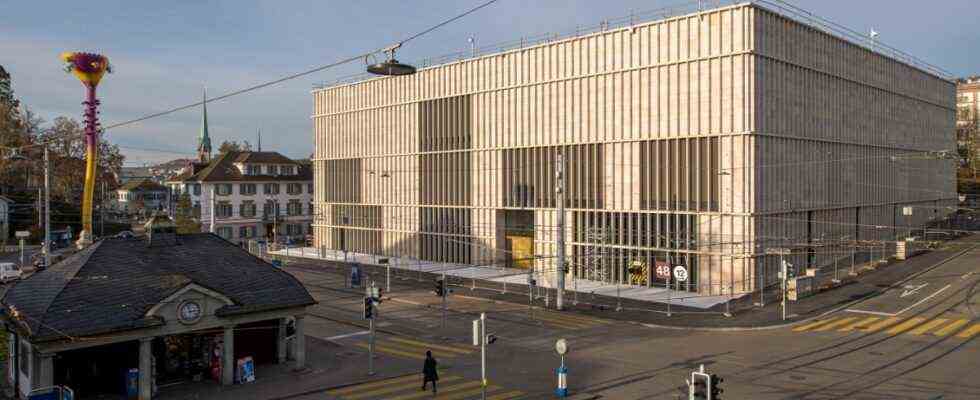Who is actually in power in Zurich? Is it the city and canton government – or is it the heirs and representatives of an art-loving arms dealer who made his living primarily from deliveries to Nazi Germany? A good month after the Zürcher Kunsthaus noticed its worldwide Extension building has opened, it is about nothing less than this question. The new building houses more than 200 works from the controversial Emil Bührle collection. Bührle, who died in 1956, a German who later became naturalized in Switzerland, was not just a man with an exquisite taste in art who gathered dozens of masterpieces of French Impressionism over the years, but an arms manufacturer who, like few others, profited from the Second World War.
The core of the controversy: Bührle’s art collection is inconceivable without his opportunistic entrepreneurship and the unique opportunities that the persecution of Jewish collectors offered the art market. Will the Zürcher Kunsthaus, which borrowed the 203 works from the Bührle Foundation, do justice to this problem? Many think: no.
Work-up? The family kept their archives under lock and key
Among the critics are now as weighty voices as those of the historian and Holocaust survivor Saul Friedländer, the Basel historian Georg Kreis or the Zurich Jakob Tanner, both recognized specialists in the history of Switzerland in the 20th century. The three experts were all members of the “Independent Expert Commission Switzerland – Second World War” (ICE). the Commission was supposed to process what had happened to the assets that had come to Switzerland during the war, and she had unrestricted access to archives for this purpose.
The Commission’s final report, published in 2002, is considered a milestone in the process of coming to terms with Switzerland’s involvement in National Socialism. However: The archive of the Bührle family remained closed to the researchers during their five years of work. Historian Georg Kreis made public in 2010that he had asked the Bührle daughter Hortense, who has since died in 2001, for access to the files of the art collection. But this had dismissed him with the assertion that there was no longer an archive – demonstrably a false claim.
The dispute had not yet escalated: Lukas Gloor, director of the Emil Bührle collection, at a media conference on the extension of the Kunsthaus Zürich.
(Photo: WALTER BIERI / picture alliance / KEYSTONE)
Now that the Bührle Collection has once again come into focus with its move to the Kunsthaus, the former members of the commission are apparently enough. They went public a few days ago. “The current situation in Zurich is an affront to potential victims of looted property,” write the 32 former members and employees of the ICE. The researchers raise explosive questions. Probably the most important: “Is it finally ensured that all works of art that have been included in the Bührle Collection are clearly identified, researched and evaluated?”
Researchers insist on the suspicion: looted art
Jakob Tanner, one of the prominent signatories, explains in an interview with the SZ: “The origin of the works is the neuralgic point of the whole Bührle scandal. And the provenance research that is available on the collection is simply inadequate.” In other words: In the opinion of the researchers, it can still not be ruled out that the works in the collection include looted art or, above all, refugee goods. The term has established itself for those special emergency situations in which refugees were no longer directly threatened, but still not sold their goods free of constraints. A key word for Switzerland, at that time a country of refuge and transit par excellence.
Historian Tanner and his ICE colleagues sharply criticize the fact that the Kunsthaus simply relies on provenance research by Lukas Gloor, the director of the Bührle Foundation. As the top manager of the collection, Tanner attests to Gloor not only bias, but also a “completely inadequate awareness of problems” with regard to Bührle’s art purchases during and immediately after the war.
Apart from questions of origin, the researchers also criticize the accompanying documentation in the Kunsthaus. Here, too, Tanner describes what the museum presents about Bührle as a person and the context of the collection as “insufficient”. The scientists are therefore making three demands: firstly, the city and canton of Zurich should review the provenance research that has been carried out, and secondly, the documentation room in the Kunsthaus should be revised by independent experts. And thirdly, they are calling for an independent body for restitution issues in Switzerland, similar to the Limbach Commission in Germany.
Surprisingly, the city and canton of Zurich – which largely finance the Kunsthaus through subsidies – came a few days after the ICE experts said with its own message nach: Support the demands of the scientists. And: When negotiating the new subsidy contract, the city will impose “obligations on the Bührle Collection” on the Kunsthaus. In other words: the central donor finally wants to put pressure on it – mind you almost 20 years after the plan to show the Bührle Collection in the Kunsthaus began to take shape.
Now one could say: Better late than never. But that in Zurich a few things got into serious trouble the interview clear, the foundation director Gloor last the Sunday look gave. He not only says the historically forgotten sentence that it should not be “that the collection becomes a memorial for Nazi persecution, that does not do justice to the pictures”. He also threatens to take the collection away from the Kunsthaus. “If the city of Zurich now dictates to the Kunsthaus how the Emil Bührle Collection is to be explained to the public, we can no longer take part.”
Now it has to show what is worth more to the Zurich authorities: an art collection with which one can decorate oneself internationally, or the honest handling of one’s own history and the associated respect for the victims of Nazi persecution.

